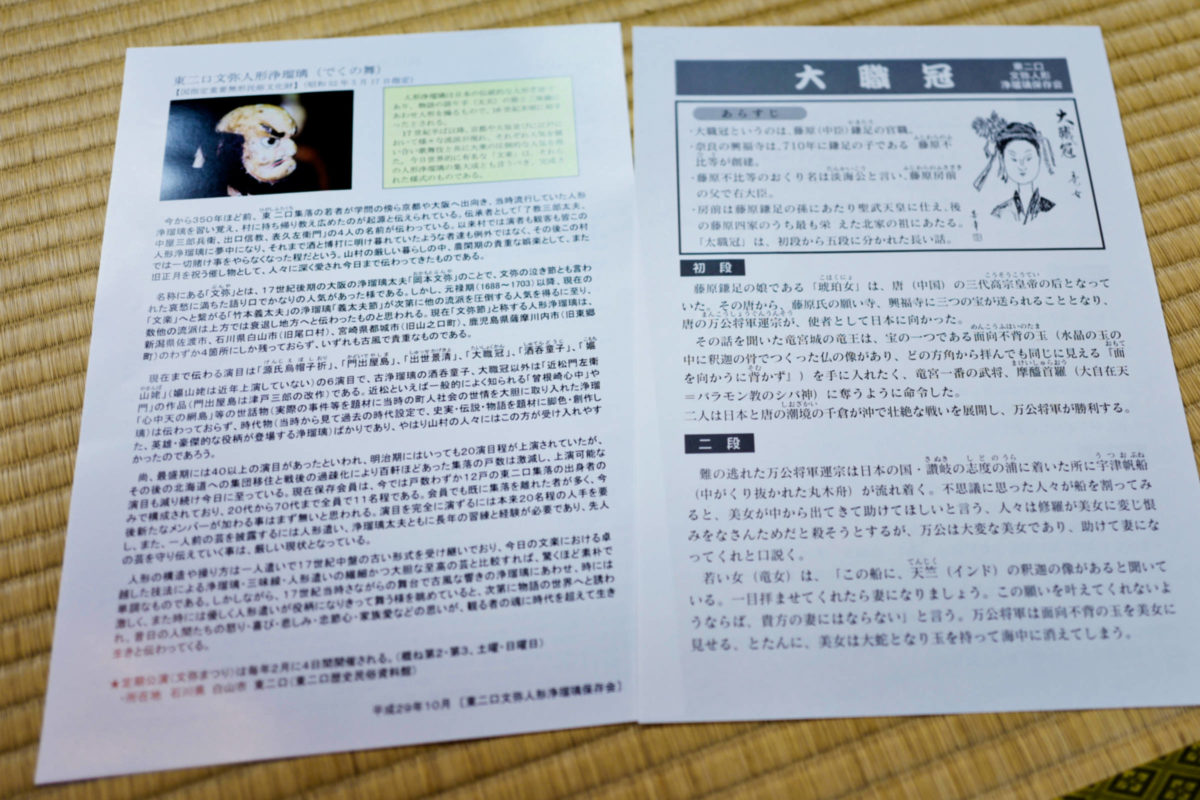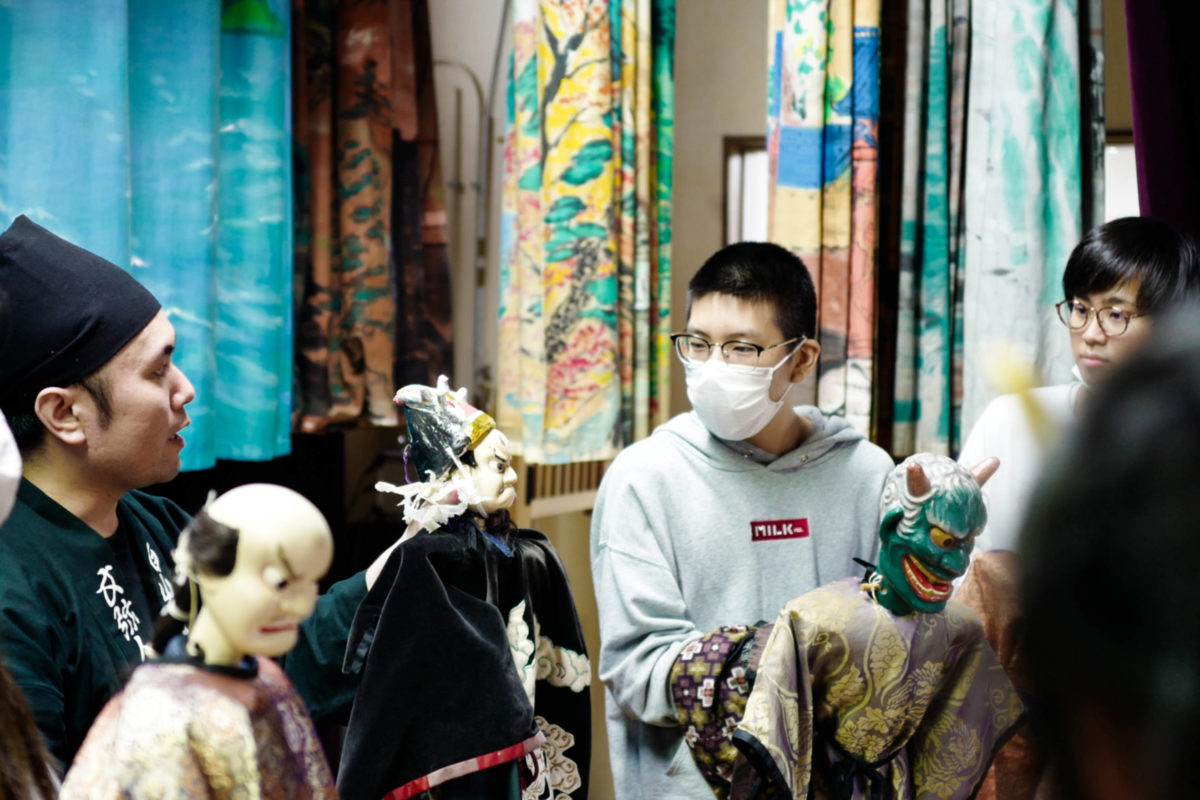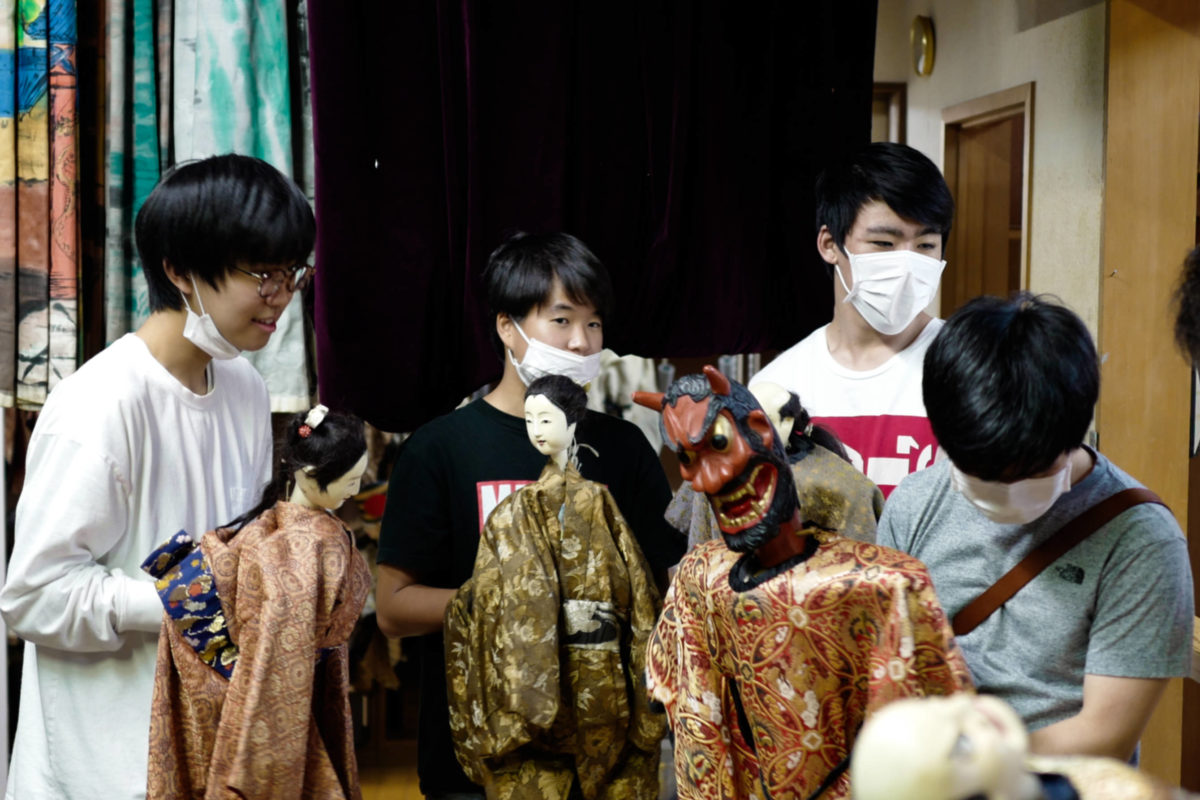July 15, 2020 文弥人形浄瑠璃 見学
 Hello, it's Jonathan, the camera man. Today I would like to reflect on the second-year students' visit to see Bunya Ningyo-Joruri in Higashi-futakuchi. That was a lot Japanese so let me explain. Ningyo-Joruri is a Japanese traditional puppet show dating back to the Edo period. The name "Bunya" came from Okamoto Bunya, who was a Ningyo-Joruri reciter in the late 17th century. He was popular in Osaka for his melancholy narrative style, also referred to as "Naki-bushi (crying tone)." However, the Bunya style gradually subsided to the "Gidayuu-bushi" by Takemoto Gidayuu. Currently, Higashi-futakuchi is one of only four places that still practice "Bunya" Ningyo-Joruri. These places include Sado city (Niigata prefecture), Miyakonojo city (Miyazaki prefecture), and Satsumasendai city (Kagoshima prefecture).
Hello, it's Jonathan, the camera man. Today I would like to reflect on the second-year students' visit to see Bunya Ningyo-Joruri in Higashi-futakuchi. That was a lot Japanese so let me explain. Ningyo-Joruri is a Japanese traditional puppet show dating back to the Edo period. The name "Bunya" came from Okamoto Bunya, who was a Ningyo-Joruri reciter in the late 17th century. He was popular in Osaka for his melancholy narrative style, also referred to as "Naki-bushi (crying tone)." However, the Bunya style gradually subsided to the "Gidayuu-bushi" by Takemoto Gidayuu. Currently, Higashi-futakuchi is one of only four places that still practice "Bunya" Ningyo-Joruri. These places include Sado city (Niigata prefecture), Miyakonojo city (Miyazaki prefecture), and Satsumasendai city (Kagoshima prefecture).
It is said that a young scholar from Higashi-futakuchi learned Ningyo-joruri while studying in Kyoto and Osaka and brought the culture back to the village more than 350 years ago. The villagers instantly became hooked on this new entertainment. It was so popular that everyone quit gambling and drinking after this. Ningyo-joruri became a valuable source of distraction in the harsh winter months when the villagers could not farm and an amusement for the lunar New Year; and it has been passed down ever since.
The second year students visited Higashi-futakuchi, which is about 10 minutes by car from Hakusanroku Campus on June 25. First, Doishita-san and Yamaguchi-san gave an introduction of the history and current state of Bunya Ningyo-Joruri. Higashi-futakuchi village used to have more than one hundred houses and the villagers performed more than 40 stories. However, due to the mass migration to Hokkaido and young people leaving for the city, now there are only twelve houses and less than twenty people who continue the practice. Still, the village has preserved five stories and plays them each year in February.
After the introduction, students watched a shorten version of "Taishokkan." This story is about a shogun who fights a dragon lord of Ryugu castle to protect the gemstone "Menko-fuhai-no-tama". The dragon lord's warlord first tries to defeat the shogun in battle. When this fails, he next transforms into a beautiful maiden and tricks the shogun into giving him the gemstone. The ancient Japanese narrative was difficult to follow. However, the action and acting was surprisingly fascinating, and I could sense the students being drawn into the performance. I was especially impressed by the way the performer moving the maiden made the puppet sob when pleading for the treasure and the way the performers stamped the stage floor during the battle scene to create tension.
After the performance, students were allowed to come behind the stage and touch the various puppets. The puppets were heavier than I expected which increased my respect for the performers holding them sometimes for multiple hours for a single show. Yamaguchi-san explained how to move the puppets and that the key is to hold the puppet up to your face so that the audience can only see the puppet. Student asked questions about how the puppets were made, the beautifully painted paper lamps in the hall, and the music played during the scene.
The second-year students are given the task of choosing a problem in the local Hakusanroku community in the Engineering Design class. After this visit to Higashi-futakuchi, three students decided to focus on the revitalization of Ningyo-joruri. The group will work together to solve problems such as lack of performers/successors, and difficulty to understand the storyline due to the old Japanese dialect next semester. I will make sure to keep you updated so stay tune.
Jonathan
こんにちは、カメラマンのジョナサンです!今日は2年生の東二口の文弥人形浄瑠璃見学について振り返りたいと思います。少し解説します。人形浄瑠璃は江戸時代から続く日本の伝統的な人形芝居です。「文弥」とは語り手の岡本文弥のことで、「泣き節」と呼ばれる哀愁に満ちた語り口が17世紀後期の大阪で人気でした。しかし、竹本義太夫節の「義太夫節」の人気が増すにつれ、他の流派は上方で衰退し、地方へ伝わったと言われています。現在「文弥節」と呼ばれる人形浄瑠璃は石川県白山市(旧尾口村)、新潟県佐渡市、宮崎県都城市(旧山之口町)、鹿児島県薩摩川内市(旧東郷町)の4か所でしか残っていません。
東二口の人形浄瑠璃は今から350年ほど前、東二口集落の若者が学問のため京都や大阪へ出向いた際、当時流行していたものを習って、村に持ち帰ったのが広まったと伝えられています。村の者は人形浄瑠璃に夢中になり、それまで酒と博打に明け暮れていたような者も一切賭け事をやらなくなった程だと言われています。農作業ができない山村の厳しい冬の貴重な娯楽として、また旧正月を祝う催し物として愛され続けて今日まで伝わってきました。
2年生が訪れた東二口は白山麓キャンパスから車で約10分の距離にあります。はじめに保存会員の土居下さんと山口さんが文弥人形浄瑠璃の歴史と現状について話をしてくれました。東二口集落は以前は100軒以上の家があり、最盛期には40以上の演目が上演されていました。しかし、北海道への集団移住と戦後の過疎化によって、現在はわずか12軒まで減少し、会員も11名ほどになってしまいました。会員でも集落を離れた者が多いですが、5つの演目を毎年2月に上演して守り伝えています。
紹介のあと、学生は演目「大職冠」の短縮版を見せていただきました。これは竜宮の武将、摩醯修羅(まけいすらおう)が唐の万公将軍運宗(まんこうしょうぐんうんそう)から面向不背の玉と呼ばれる宝玉を奪おうとする場面でした。最初、竜宮の武将は武力で宝玉を奪おうとしますが、運宗に返り討ちに遭います。しかし、今度は美女に化けて運宗から宝玉をだまし取り、大蛇に変身して海に逃れます。語り手の古い日本語は難解でしたが、演者の演技と動きの迫力は想像以上で、学生たちが引き込まれるのを感じました。特に美女の人形を操り、袖を濡らして助けを乞う演技と、戦闘の迫力を増すために舞台を足で踏み叩く演技は圧巻でした。
演目が終わったあと、会員たちが学生達を舞台の上に招いて、たくさんある人形を触らせてくれました。人形は思った以上に重く、中には5時間以上も続く演目を通して操る凄さを感じました。山口さんによると人形を操るコツは顔の前に人形を構え、観客に演者の顔を見せないことだそうです。学生たちは人形の作り方、ホールに飾られている絵が描かれている提灯のこと、演目中に鳴っている三味線の音楽について質問をしました。
2年生はエンジニアリングデザインという授業で白山麓地域の課題をひとつ選び、課題解決をします。東二口を訪ねた数日後、3人の学生が人形浄瑠璃の再興をテーマにすることを選びました。このグループは後学期、文弥人形浄瑠璃が抱える演者・後継者不足、難解な古い日本語などの課題に着目して創造活動を行います。プロジェクトが進みましたら、すぐにお知らせしたいと思います。
ジョナサン
July 15, 2020 文弥人形浄瑠璃 見学
 Hello, it's Jonathan, the camera man. Today I would like to reflect on the second-year students' visit to see Bunya Ningyo-Joruri in Higashi-futakuchi. That was a lot Japanese so let me explain. Ningyo-Joruri is a Japanese traditional puppet show dating back to the Edo period. The name "Bunya" came from Okamoto Bunya, who was a Ningyo-Joruri reciter in the late 17th century. He was popular in Osaka for his melancholy narrative style, also referred to as "Naki-bushi (crying tone)." However, the Bunya style gradually subsided to the "Gidayuu-bushi" by Takemoto Gidayuu. Currently, Higashi-futakuchi is one of only four places that still practice "Bunya" Ningyo-Joruri. These places include Sado city (Niigata prefecture), Miyakonojo city (Miyazaki prefecture), and Satsumasendai city (Kagoshima prefecture).
Hello, it's Jonathan, the camera man. Today I would like to reflect on the second-year students' visit to see Bunya Ningyo-Joruri in Higashi-futakuchi. That was a lot Japanese so let me explain. Ningyo-Joruri is a Japanese traditional puppet show dating back to the Edo period. The name "Bunya" came from Okamoto Bunya, who was a Ningyo-Joruri reciter in the late 17th century. He was popular in Osaka for his melancholy narrative style, also referred to as "Naki-bushi (crying tone)." However, the Bunya style gradually subsided to the "Gidayuu-bushi" by Takemoto Gidayuu. Currently, Higashi-futakuchi is one of only four places that still practice "Bunya" Ningyo-Joruri. These places include Sado city (Niigata prefecture), Miyakonojo city (Miyazaki prefecture), and Satsumasendai city (Kagoshima prefecture).
It is said that a young scholar from Higashi-futakuchi learned Ningyo-joruri while studying in Kyoto and Osaka and brought the culture back to the village more than 350 years ago. The villagers instantly became hooked on this new entertainment. It was so popular that everyone quit gambling and drinking after this. Ningyo-joruri became a valuable source of distraction in the harsh winter months when the villagers could not farm and an amusement for the lunar New Year; and it has been passed down ever since.
The second year students visited Higashi-futakuchi, which is about 10 minutes by car from Hakusanroku Campus on June 25. First, Doishita-san and Yamaguchi-san gave an introduction of the history and current state of Bunya Ningyo-Joruri. Higashi-futakuchi village used to have more than one hundred houses and the villagers performed more than 40 stories. However, due to the mass migration to Hokkaido and young people leaving for the city, now there are only twelve houses and less than twenty people who continue the practice. Still, the village has preserved five stories and plays them each year in February.
After the introduction, students watched a shorten version of "Taishokkan." This story is about a shogun who fights a dragon lord of Ryugu castle to protect the gemstone "Menko-fuhai-no-tama". The dragon lord's warlord first tries to defeat the shogun in battle. When this fails, he next transforms into a beautiful maiden and tricks the shogun into giving him the gemstone. The ancient Japanese narrative was difficult to follow. However, the action and acting was surprisingly fascinating, and I could sense the students being drawn into the performance. I was especially impressed by the way the performer moving the maiden made the puppet sob when pleading for the treasure and the way the performers stamped the stage floor during the battle scene to create tension.
After the performance, students were allowed to come behind the stage and touch the various puppets. The puppets were heavier than I expected which increased my respect for the performers holding them sometimes for multiple hours for a single show. Yamaguchi-san explained how to move the puppets and that the key is to hold the puppet up to your face so that the audience can only see the puppet. Student asked questions about how the puppets were made, the beautifully painted paper lamps in the hall, and the music played during the scene.
The second-year students are given the task of choosing a problem in the local Hakusanroku community in the Engineering Design class. After this visit to Higashi-futakuchi, three students decided to focus on the revitalization of Ningyo-joruri. The group will work together to solve problems such as lack of performers/successors, and difficulty to understand the storyline due to the old Japanese dialect next semester. I will make sure to keep you updated so stay tune.
Jonathan
こんにちは、カメラマンのジョナサンです!今日は2年生の東二口の文弥人形浄瑠璃見学について振り返りたいと思います。少し解説します。人形浄瑠璃は江戸時代から続く日本の伝統的な人形芝居です。「文弥」とは語り手の岡本文弥のことで、「泣き節」と呼ばれる哀愁に満ちた語り口が17世紀後期の大阪で人気でした。しかし、竹本義太夫節の「義太夫節」の人気が増すにつれ、他の流派は上方で衰退し、地方へ伝わったと言われています。現在「文弥節」と呼ばれる人形浄瑠璃は石川県白山市(旧尾口村)、新潟県佐渡市、宮崎県都城市(旧山之口町)、鹿児島県薩摩川内市(旧東郷町)の4か所でしか残っていません。
東二口の人形浄瑠璃は今から350年ほど前、東二口集落の若者が学問のため京都や大阪へ出向いた際、当時流行していたものを習って、村に持ち帰ったのが広まったと伝えられています。村の者は人形浄瑠璃に夢中になり、それまで酒と博打に明け暮れていたような者も一切賭け事をやらなくなった程だと言われています。農作業ができない山村の厳しい冬の貴重な娯楽として、また旧正月を祝う催し物として愛され続けて今日まで伝わってきました。
2年生が訪れた東二口は白山麓キャンパスから車で約10分の距離にあります。はじめに保存会員の土居下さんと山口さんが文弥人形浄瑠璃の歴史と現状について話をしてくれました。東二口集落は以前は100軒以上の家があり、最盛期には40以上の演目が上演されていました。しかし、北海道への集団移住と戦後の過疎化によって、現在はわずか12軒まで減少し、会員も11名ほどになってしまいました。会員でも集落を離れた者が多いですが、5つの演目を毎年2月に上演して守り伝えています。
紹介のあと、学生は演目「大職冠」の短縮版を見せていただきました。これは竜宮の武将、摩醯修羅(まけいすらおう)が唐の万公将軍運宗(まんこうしょうぐんうんそう)から面向不背の玉と呼ばれる宝玉を奪おうとする場面でした。最初、竜宮の武将は武力で宝玉を奪おうとしますが、運宗に返り討ちに遭います。しかし、今度は美女に化けて運宗から宝玉をだまし取り、大蛇に変身して海に逃れます。語り手の古い日本語は難解でしたが、演者の演技と動きの迫力は想像以上で、学生たちが引き込まれるのを感じました。特に美女の人形を操り、袖を濡らして助けを乞う演技と、戦闘の迫力を増すために舞台を足で踏み叩く演技は圧巻でした。
演目が終わったあと、会員たちが学生達を舞台の上に招いて、たくさんある人形を触らせてくれました。人形は思った以上に重く、中には5時間以上も続く演目を通して操る凄さを感じました。山口さんによると人形を操るコツは顔の前に人形を構え、観客に演者の顔を見せないことだそうです。学生たちは人形の作り方、ホールに飾られている絵が描かれている提灯のこと、演目中に鳴っている三味線の音楽について質問をしました。
2年生はエンジニアリングデザインという授業で白山麓地域の課題をひとつ選び、課題解決をします。東二口を訪ねた数日後、3人の学生が人形浄瑠璃の再興をテーマにすることを選びました。このグループは後学期、文弥人形浄瑠璃が抱える演者・後継者不足、難解な古い日本語などの課題に着目して創造活動を行います。プロジェクトが進みましたら、すぐにお知らせしたいと思います。
ジョナサン

















